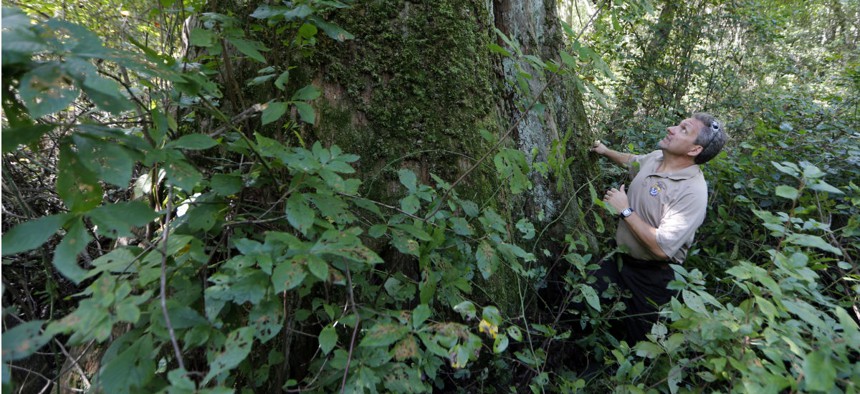
The Interior Department plans to relocate employees to be closer to public lands predominately in the West. Above, Chris Lowie, refuge manager Great Dismal Swamp National Wildlife Refuge, surveys a rare large cypress tree in Suffolk, Va., in 2017. Steve Helber/AP
Relocations, Buyouts Tucked Into Trump's Budget
While it reversed its push for governmentwide staffing cuts, some agencies are still pushing "workforce reshaping."
In a surprise move, the White House, in its latest budget blueprint, proposed most major agencies grow their workforces.
The suggested staffing increases marked a dramatic shift after President Trump in his first two budgets called on agencies across government slash their rolls. The increases were not across the board, however. Some agencies will still have to make downward adjustments. In those cases, the administration budgeted for buyout payments, relocation incentives and other workforce reshaping initiatives.
The Interior Department, for example, requested $10.5 million for relocation costs as it looks to implement its restructuring plan. The department recently unveiled a plan to reorganize its non-Washington, D.C. offices into 12 unified regions. In the fiscal 2019 spending bill Trump signed earlier this year, lawmakers provided Interior $14 million to begin its reorganization. The department said the moves would put more resources in the western part of the country, closer to the majority of the lands it manages.
The Agriculture Department requested $25 million to relocate two of its offices outside of Washington: the Economic Research Service and the National Institute of Food and Agriculture. The budget also suggested overall cuts to both offices to accompany the controversial relocations.
USDA plans to reduce its workforce by 2,000 employees in fiscal 2020, with many of the cuts focusing on its Rural Development office.
The Environmental Protection Agency once again requested funds for “workforce reshaping,” asking for $31 million as part of its effort to slash 15 percent of its workforce. Congress provided no money for such efforts in fiscal years 2018 and 2019, though the agency did offer buyouts and early retirements in 2017. EPA said it would again offer those incentives in 2020, as well as relocation offers.
“To help achieve its mission, EPA will develop, review and analyze mission requirements and implement options to effectively align and redistribute the agency’s workforce based on program priorities, resource reallocation, and technological advances,” it wrote in its budget proposal. “Effective workforce reshaping is critical to EPA’s ability to accomplish its mission. EPA will be examining our statutory functions and processes to eliminate inefficiencies and streamline our processes.”
Winning congressional support for those efforts could prove difficult. In an explanatory statement accompanying the last spending bill, lawmakers made clear they were providing no funds for workforce reshaping.
The Defense Department plans to add to its civilian rolls overall to accompany ongoing increases to military personnel. The Pentagon is still moving forward on its plans to cut staffing in headquarters offices. The Army, specifically, plans to cut more than 2,000 civilian jobs, citing the restructuring and realigning of costs.
The Equal Employment Opportunity Commission also announced planned reductions, citing early Office of Management and Budget guidance requiring all agencies to develop “long-term workforce reduction plans.” The administration appears to have largely moved away from the staffing priorities spelled out in that document.
“I will say it more and more: if people want to be here working in government, our goal is not to eliminate those people,” Margaret Weichert, OMB’s deputy director for management, said this week. “In fact, there are many missions where I need more people.”
Still, EEOC said it will soon create a workforce plan to “reduce duplicative efforts and improve organizational efficiencies and effectiveness.” EEOC said it will partner with the Office of Personnel Management, which Weichert also heads in an acting capacity, to more efficiently structure its workforce to meet mission demands.
The administration identified agencies where it wants to grow the workforce, including the Census Bureau, where it plans to bring on hundreds of thousands of temporary employees to prepare for the decennial count. As in years past, the departments of Veterans Affairs and Homeland Security plan to hire the most permanent workers. The Housing and Urban Development Department said it plans to reverse a “decades-old trend” of shedding staff, requesting a $56 million boost to aid in those efforts. HUD was one of several agencies to outline steps it would take to streamline its hiring process.
The Small Business Administration will aim to slightly reduce its workforce, but plans to treat those who stick around better. It recently hired a “work-life coordinator” as part of its goal to retain 80 percent of its hires for at least two years.
NEXT STORY: When and Why You Have to Take TSP Withdrawals







